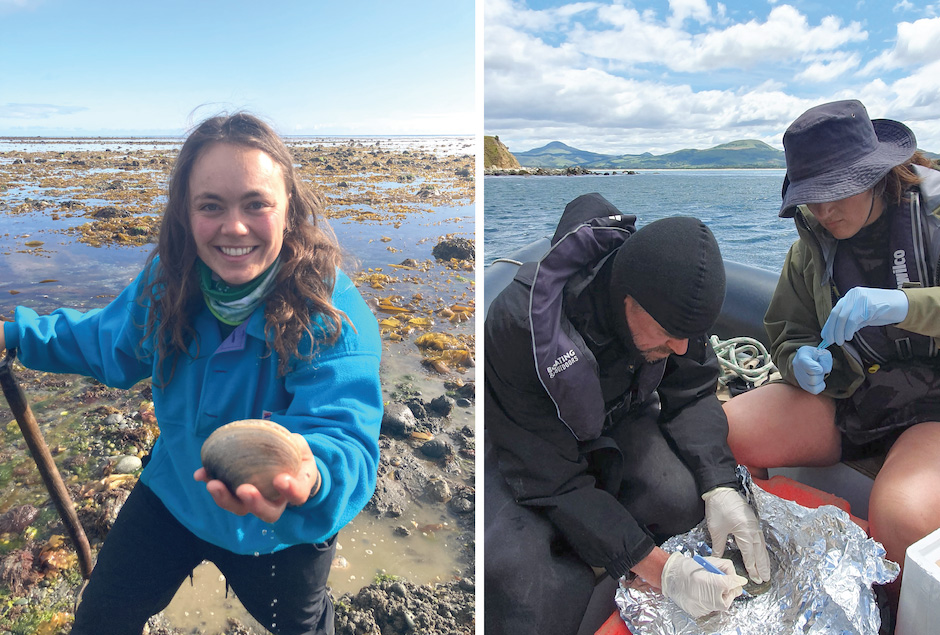
Left: Dr Roseanna Gamlen-Greene on a previous research project in Haida Gwaii, Canada (photo: Ralph Stocker). Right: members of the Ngāi Tahu dive team Kane Holmes (left) and Jess Wenley sampling pāua last month.
Dr Roseanna Gamlen-Greene, a postdoctoral researcher in the Kenny Lab in the Department of Biochemistry, has just been awarded one of the first Ngā Puanga Pūtaiao Fellowships, a new type of fellowship designed to support Māori and Pasifika talent in science.
Roseanna (Waikato-Tainui; Ngāti Kautawhiti, Pākehā) is a restoration ecologist who specialises in ecological projects with communities, and is a keen science communicator. She is a National Geographic Explorer, previously receiving an Early Career Grant from the National Geographic Society. She will use her Ngā Puanga Pūtaiao fellowship to collaborate on Māori-led initiatives aiming to restore taonga (culturally treasured) species.
One of these projects is based in the Biochemistry Department (Te Tari Matū Koiora), where Roseanna will work in collaboration with Dr Nathan Kenny (Kāi Tahu, Te Ātiawa, Pākehā), and also Dr Catherine Collins (Kāi Tahu, Pākehā) and Dr Alana Alexander (Te Hikutū: Ngāpuhi, Pākehā), both from the Department of Anatomy (Te Tari Kikokiko).
Working closely with hapori Māori (Māori communities) in southern New Zealand Aotearoa, they aim to study the resilience and vulnerability of kaimoana (sea food) such as pāua, kina and kōura to marine heatwave events, at a molecular level, to help manage these species in a future impacted by climate change.
The communities involved so far in the pāua research project are the East Otago Taiāpure – including Kāti Huirapa ki Puketeraki – near Karitane, and the Makaawhio Mātaitai near Haast. The resulting data will be helpful for kaitiakitanga (guardianship) of these taonga.
Marine heatwaves threaten ecosystems worldwide, and are increasing in frequency in Aotearoa, but we do not fully understand how our kaimoana, already in decline due to factors such as over-fishing and ecosystem changes, are responding to these heatwaves.
The main technique Roseanna’s team will use is transcriptomics: sampling RNA molecules (copies of small sections of DNA that code for genes) to find out which genes are being turned on by kaimoana in response to heat stress, and to what extent.
They will also figure out whether kaimoana in different regions are more heat stressed than in others, if this depends on the size of individuals, and the whakapapa (relatedness) of kaimona species between regions.
The project is already off to a good start – a Ngāi Tahu dive team sampled pāua in Karitane in December for the project.
The pāua component of this project is also supported by the Mike Murphy Early Career Grant and a grant from Genomics Aotearoa. The project is also connected to a larger collaborative research program with coastal communities (Te Tiaki Mahinga Kai), supported by Coastal People: Southern Skies, a Centre of Research Excellence.
Ngā Puanga Pūtaiao Fellowships are administered by the Royal Society Te Apārangi on behalf the Ministry of Business, Innovation and Employment, and aim to “attract and grow Māori [and Pasifika] talent in the research, science and innovation system, enable them to better navigate and participate in this system and fund Māori [and Pasifika]-led research, science and innovation.”
Ngā Puanga Pūtaiao translates to “the scientific blossoms/flowers” and refers to the early- and mid-career stage of scientific (Pūtaiao) researchers, when researchers are blooming and demonstrating their talent and potential (Puanga).
Roseanna’s early-career Ngā Puanga Pūtaiao fellowship is worth $800,000 over four years.